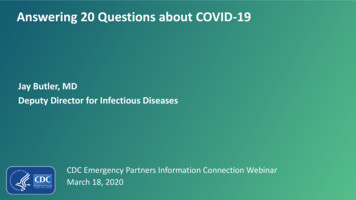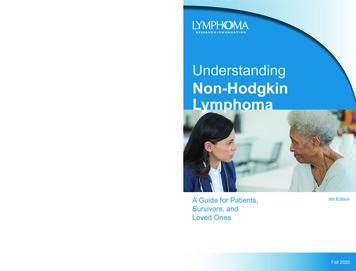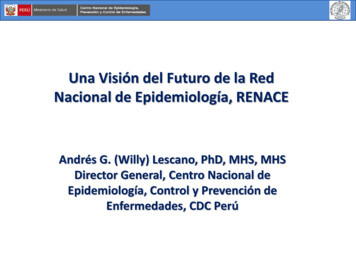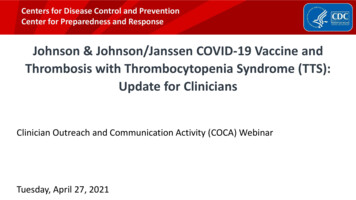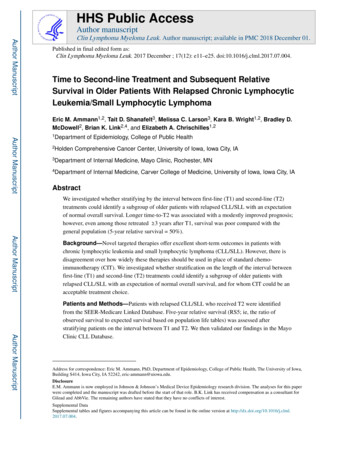
Transcription
HHS Public AccessAuthor manuscriptAuthor ManuscriptClin Lymphoma Myeloma Leuk. Author manuscript; available in PMC 2018 December 01.Published in final edited form as:Clin Lymphoma Myeloma Leuk. 2017 December ; 17(12): e11–e25. doi:10.1016/j.clml.2017.07.004.Time to Second-line Treatment and Subsequent RelativeSurvival in Older Patients With Relapsed Chronic LymphocyticLeukemia/Small Lymphocytic LymphomaEric M. Ammann1,2, Tait D. Shanafelt3, Melissa C. Larson3, Kara B. Wright1,2, Bradley D.McDowell2, Brian K. Link2,4, and Elizabeth A. Chrischilles1,2Author Manuscript1Department2Holdenof Epidemiology, College of Public HealthComprehensive Cancer Center, University of Iowa, Iowa City, IA3Departmentof Internal Medicine, Mayo Clinic, Rochester, MN4Departmentof Internal Medicine, Carver College of Medicine, University of Iowa, Iowa City, IAAbstractWe investigated whether stratifying by the interval between first-line (T1) and second-line (T2)treatments could identify a subgroup of older patients with relapsed CLL/SLL with an expectationof normal overall survival. Longer time-to-T2 was associated with a modestly improved prognosis;however, even among those retreated 3 years after T1, survival was poor compared with thegeneral population (5-year relative survival 50%).Author ManuscriptBackground—Novel targeted therapies offer excellent short-term outcomes in patients withchronic lymphocytic leukemia and small lymphocytic lymphoma (CLL/SLL). However, there isdisagreement over how widely these therapies should be used in place of standard chemoimmunotherapy (CIT). We investigated whether stratification on the length of the interval betweenfirst-line (T1) and second-line (T2) treatments could identify a subgroup of older patients withrelapsed CLL/SLL with an expectation of normal overall survival, and for whom CIT could be anacceptable treatment choice.Author ManuscriptPatients and Methods—Patients with relapsed CLL/SLL who received T2 were identifiedfrom the SEER-Medicare Linked Database. Five-year relative survival (RS5; ie, the ratio ofobserved survival to expected survival based on population life tables) was assessed afterstratifying patients on the interval between T1 and T2. We then validated our findings in the MayoClinic CLL Database.Address for correspondence: Eric M. Ammann, PhD, Department of Epidemiology, College of Public Health, The University of Iowa,Building S414, Iowa City, IA 52242, eric-ammann@uiowa.edu.DisclosureE.M. Ammann is now employed in Johnson & Johnson’s Medical Device Epidemiology research division. The analyses for this paperwere completed and the manuscript was drafted before the start of that role. B.K. Link has received compensation as a consultant forGilead and AbbVie. The remaining authors have stated that they have no conflicts of interest.Supplemental DataSupplemental tables and figures accompanying this article can be found in the online version at http://dx.doi.org/10.1016/j.clml.2017.07.004.
Ammann et al.Page 2Author ManuscriptResults—Among 1974 SEER-Medicare patients (median age 77 years) who received T2 forrelapsed CLL/SLL, longer time-to-retreatment was associated with a modestly improved prognosis(P .01). However, even among those retreated 3 years after T1, survival was poor comparedwith the general population (RS5 0.50 or lower in SEER-Medicare). Similar patterns wereobserved in the younger Mayo validation cohort, although prognosis was better overall among theMayo patients, and patients with favorable fluorescence in situ hybridization retreated 3 yearsafter T1 had close to normal expected survival (RS5 0.87).Conclusion—Further research is needed to quantify the degree to which targeted therapiesprovide meaningful improvements over CIT in long-term outcomes for older patients withrelapsed CLL/SLL.KeywordsAuthor ManuscriptMortality; Prognosis; SEER-MedicareIntroductionAuthor ManuscriptNovel therapies available targeting Bruton’s tyrosine kinase, PI-3 kinase, and bcl-2 havedemonstrated excellent short-term outcomes in patients with chronic lymphocytic leukemiaand small lymphocytic lymphoma (CLL/SLL).1–3 Particularly for patients with an otherwisepoor prognosis, these treatments are likely to be transformative. However, these agents mustbe taken indefinitely, are costly ( 100,000– 150,000 annually),4,5 and carry risks ofsignificant side effects (eg, atrial fibrillation, colitis, infection, and tumor lysis syndrome).6For these reasons, it is important to identify the CLL/SLL patients for whom these newagents are most likely to provide a meaningful benefit compared with standard chemoimmunotherapy (CIT) regimens. Additionally, it would be useful to identify subgroups ofpatients with relapsed or refractory CLL/SLL who are at low risk for premature mortalitywith standard CIT options, and thus would have a suitable alternative to long-term use ofnewer agents.Author ManuscriptIn patients with relapsed CLL/SLL, the time interval from initial therapy until relapse isrecognized as an important prognostic marker. Patients who relapse sooner are lessresponsive to subsequent treatments and have shorter overall survival (OS).7–9 Thisassociation has been characterized in a younger patient cohort (median age 60 years) thatreceived first-line treatment with fludarabine, cyclophosphamide, and rituximab (FCR).Median OS following relapse was 13 months among patients who relapsed in less than 3years, as compared with 63 months in those who relapsed in 3 years.10 However, becausethe median age at diagnosis for CLL/SLL is 71 years,11 these results may not begeneralizable to most patients with CLL/SLL. Older patients typically receive less intensiveantineoplastic therapies, and OS patterns following relapse are likely to be different in olderadults due to competing risks of mortality. A more precise characterization of thisrelationship in older adults will inform clinicians’ efforts to risk-stratify and appropriatelytreat older patients with relapsed CLL/SLL.In this study we assessed the prognostic value of time-until-retreatment in predictingsubsequent OS among older CLL/SLL cases identified from the Surveillance, Epidemiology,Clin Lymphoma Myeloma Leuk. Author manuscript; available in PMC 2018 December 01.
Ammann et al.Page 3Author Manuscriptand End Results (SEER)-Medicare Linked Database (SEER-Medicare) and an independentvalidation cohort identified from the Mayo Clinic CLL Database. We hypothesized that,before the era of novel targeted therapies, patients retreated 3 years after their first courseof antineoplastic therapy would have OS close to that expected in the US general populationafter controlling for age, sex, and calendar year.MethodsData SourcesAuthor ManuscriptThe study data for the SEER-Medicare patient cohort were obtained from the 2014 SEERMedicare linkage, which included SEER cancer cases diagnosed from 1973 to 2011 andtheir Medicare claims from 1992 to 2013. Within SEER registry catchment areas, 93% ofpatients aged 65 years diagnosed with cancer have been linked to their Medicare claimsdata.12 Participating registries collect data for all patients with cancer diagnosed within theirdefined geographic area. Registry data include month and year of diagnosis, age atdiagnosis, race, tumor stage, and histology. Medicare files from the Centers for Medicareand Medicaid Services (CMS) include demographic and enrollment information, date ofdeath, and all bills submitted for inpatient hospital care, outpatient hospital care, physicianservices, and prescription fills.Author ManuscriptNormative mortality rates based on the US general population were obtained from TheHuman Mortality Database,13 which assembles historical US life tables based on datapublished by the US Census Bureau14 and National Center for Health Statistics.15 Asdescribed in the statistical methods section, these data were used for the relative survivalestimates used to describe CLL/SLL patients’ prognosis compared with age- and sexmatched controls.Institutional Review Board Review and Research EthicsThis research project was approved by SEER-Medicare Program staff and the University ofIowa Institutional Review Board (IRB). The University of Iowa IRB granted a waiver ofinformed consent because the project consisted of a secondary analysis of existing data.SEER-Medicare Program staff reviewed the manuscript to ensure that it met reportingrequirements to protect patient confidentiality. The validation study in the Mayo Clinic CLLDatabase, described at the end of the methods section, was performed with the approval ofthe Mayo Clinic IRB.Cohort DefinitionAuthor ManuscriptOur study population consisted of patients who at age 66 years were diagnosed withCLL/SLL from 1992 to 2011. Cases were excluded if they had no specific diagnosis monthrecorded by SEER, had a prior malignancy, had inconsistent birth or death dates recorded bySEER and CMS, were diagnosed at death, did not have microscopic or laboratory diagnosticconfirmation, were not enrolled in traditional fee-for-service Medicare Parts A and B atdiagnosis and the prior 365 days, or had claims for antineoplastic therapy before thediagnosis date recorded by SEER (Figure 1). The age and Medicare eligibility restrictionsClin Lymphoma Myeloma Leuk. Author manuscript; available in PMC 2018 December 01.
Ammann et al.Page 4Author Manuscriptensured that we could evaluate patients’ receipt of antineoplastic therapy, comorbidityburden, and proxies for CLL/SLL progression using Medicare claims data.Patients in this CLL/SLL inception cohort became eligible for inclusion in the present studyon receiving first- and second-line courses of antineoplastic therapy. Follow-up began on thedate that second-line therapy was initiated. Patients were excluded if prior to second-linetreatment any of the following censoring events occurred: death, the end of the study period(December 31, 2013), loss of traditional Medicare enrollment, diagnosis with a secondprimary malignancy, or initiation of ibrutinib (a novel Bruton tyrosine kinase inhibitorinitially approved in 2013). Cohort identification steps are shown in Figure 1.Author ManuscriptWe restricted our study sample to patients whose first course of antineoplastic therapy wasno more than 365 days. For most CLL/ SLL chemotherapy regimens, the treatment planwould consist of 6 cycles of treatment at 4-week intervals. Some patients may discontinuetreatment early or take breaks between treatment cycles, and treatment with some agents (eg,chlorambucil or rituximab monotherapy) may continue for 12 months. We further restrictedto patients in whom the start of the second treatment course was at least 183 days after theend of the first treatment course. This requirement was motivated by concerns that parsingshorter gaps between treatment episodes into distinct treatment courses would be difficultbased solely on claims data. In addition, patients who relapse fewer than 6 months after theirlast antineoplastic treatment are considered to have refractory CLL/SLL, and are known tohave a poor prognosis.9,16Exposure DefinitionAuthor ManuscriptThe main prognostic factor of interest was time-until-retreatment, defined as the differencein years between the end of the first course of antineoplastic therapy and the beginning ofthe second course of antineoplastic therapy. Receipt of antineoplastic treatment was assessedusing procedure, diagnosis, and drug codes recorded in Medicare inpatient, outpatient, andprescription claims. See Supplemental Tables 1 and 2 (in the online version) for details onthe codes and code ranges that were used. Corticosteroids were not included in our studydefinition of antineoplastic therapy because they are frequently used for other indications,and rarely used as monotherapy for CLL/SLL. Drug-specific Healthcare Common ProcedureCoding System (HCPCS) and National Drug Codes (NDCs) were used to identify specificantineoplastic agents administered. Patients were classified as having received chemoimmunotherapy (CIT), chemotherapy, or immunotherapy. More details on the specifictreatment regimens that patients received are provided in Supplemental Table 3 (in theonline version).Author ManuscriptA course of treatment was defined as beginning on the start date associated with the firstclaim where antineoplastic therapy was recorded, continuing for as long as additional claimswere observed (allowing for gaps of no more than 90 days), and ending on the end date ofthe last claim in the series. A prior chart validation study performed in patients withlymphoma found that Medicare claims data generally provide reliable information onwhether and when patients receive chemotherapy.17Clin Lymphoma Myeloma Leuk. Author manuscript; available in PMC 2018 December 01.
Ammann et al.Page 5Study EndpointAuthor ManuscriptThe study endpoint was all-cause mortality. The SEER-Medicare dataset includes eachpatient’s date of death as recorded in the Social Security Death Master File. In the files usedin the present study from the 2014 SEER-Medicare linkage, mortality data were availablethrough the end of 2013. Patients who were alive on December 31, 2013, were rightcensored in our survival analyses.Statistical MethodsAuthor ManuscriptFive-year relative survival (RS5) was used to characterize the prognosis of patients withCLL/SLL. RS5, the ratio of 5-year observed OS relative to OS in the general populationafter conditioning on age, sex, and calendar year, was estimated with the Ederer IImethod.18–20 RS measures are frequently used in cancer epidemiology as indirect estimatesof the burden of cancer-specific mortality in defined patient populations. The statisticalsignificance of differences and trends in RS across patient subgroups was assessed using theadditive hazards model endorsed by Dickman et al19 for analyses of relative survival datawithin a generalized linear models framework.CovariatesAuthor ManuscriptA number of demographic and clinical characteristics were assessed to characterize ourstudy sample (see Table 1), and to explore possible modification of the relationship betweentime-to-retreatment and relative survival. As a summary measure of comorbidity burden, wereport a count of the following 12 major comorbidities included in the National CancerInstitute and Charlson comorbidity indices21–23: cerebrovascular disease, chronic pulmonarydisease, congestive heart failure, dementia, diabetes, hemiplegia/paraplegia, liver disease,myocardial infarction, peptic ulcer disease, renal disease, rheumatic disease, and humanimmunodeficiency virus infection. In addition, we provide data on the frequency of severalhealth conditions associated with advanced CLL/SLL disease (eg, anemia and infection).Health conditions and health care utilization were assessed based on administrativediagnosis codes recorded during the year before retreatment. Following the approach ofKlabunde et al,23 a condition was considered present if a corresponding inpatient diagnosiscode or 2 outpatient diagnosis codes 30 days apart were observed. A higher standard wasrequired for outpatient diagnosis codes, because they can sometimes reflect diagnoses thatwere ruled out or merely considered as part of a differential diagnosis.Validation Study in Mayo Clinic CLL DatabaseAuthor ManuscriptData for the validation cohort were obtained from the Mayo Clinic CLL Database with theapproval of the Mayo Clinic IRB. The database includes patients with a diagnosis ofCLL/SLL seen in the Division of Hematology at the Mayo Clinic since 1995. Clinicalinformation regarding date of diagnosis, baseline evaluation, prognostic parameters,treatment history, and disease-related complications was abstracted from clinical records onall patients and maintained in the database on an ongoing prospective basis. Additionaldetails about the Mayo Clinic CLL Database may be found in prior publications.24,25Clin Lymphoma Myeloma Leuk. Author manuscript; available in PMC 2018 December 01.
Ammann et al.Page 6Author ManuscriptThe validation study cohort included patients diagnosed with CLL/SLL from 1995 to 2013,and longitudinal follow-up data through 2016. All patients with CLL/SLL who receivedsecond-line therapy during this period were identified, classified based on the time-toretreatment, and followed until death or censoring. RS5 from the initiation of second-linetherapy was estimated with the relsurv package for R.26,27 RS5 was estimated for patientsubgroups defined by time-to-retreatment, type of first-line antineoplastic therapy received(CIT, chemotherapy, or immunotherapy), IGHV mutation status, and whether 11q or 17pchromosome deletions were detected through fluorescence in situ hybridization (FISH).ResultsAuthor ManuscriptDuring 1992 to 2011, there were 6044 CLL/SLL cases identified from SEER-Medicare whoinitiated first-line therapy and were eligible for continued follow-up. Of this group, 1974initiated second-line therapy before censoring and were included in our analyses (Figure 1).As first-line treatment, 693 patients had received CIT (35%), 824 chemotherapy alone(42%), and 457 immunotherapy alone (23%). Frequencies of specific treatment regimens areprovided in Supplemental Table 3 (in the online version). At retreatment, the patients had amedian age of 77 years (interquartile range: 73–82); 44% were women. Additional patientcharacteristics are shown in Table 1.Author ManuscriptRS5 following second-line treatment was modestly higher in patients retreated 3 yearsafter first-line treatment (0.49; 95% confidence interval, 0.40–0.58) compared with patientsretreated in 6 months to 2 years (0.42; 95% CI, 0.38–0.45) or 2 to 3 years (0.42; 95% CI,0.35–0.50; test for trend: P .01). The relationship between time-until-retreatment andsubsequent RS5 varied by the type of first-line treatment received (Figure 2A). A protectiveassociation between longer time-until-retreatment and RS5 was seen among patients whoreceived chemotherapy alone (P .004) or CIT (P .054). No clear pattern was observed inpatients who received immunotherapy alone (P .71) as first-line treatment.In additional subgroup analyses, we explored whether the association between time-untilretreatment and subsequent RS5 varied by number of treatment cycles received during firstline therapy, patient age, or comorbidity burden. The relationship between longer time-untilretreatment and improved subsequent RS5 was most pronounced among those whose firstline treatment course included 3 treatment cycles (Supplemental Figure 1 in the onlineversion), who were 80 years or older (Supplemental Figure 2 in the online version), andwho had no major comorbidities (Supplemental Figure 3 in the online version). However,across all subgroups of retreated patients, survival was meaningfully reduced compared withappropriate age- and gender-matched cohorts from the US general population.Author ManuscriptMayo Clinic Validation StudyThe validation cohort consisted of 508 patients identified from the Mayo Clinic CLLDatabase who received second-line antineo-plastic therapy. The median patient age was 66years (interquartile range: 59–74); 28% were women; and 58%, 29%, and 12% had receivedCIT, chemotherapy alone, and immunotherapy alone as first-line treatment, respectively (seeTable 2). RS5 estimates were 0.52, 0.60, and 0.70 for patients retreated in 6 months to 2years, 2 to 3 years, and 3 years, respectively (test for trend: P .09). Similar patternsClin Lymphoma Myeloma Leuk. Author manuscript; available in PMC 2018 December 01.
Ammann et al.Page 7Author Manuscriptwere observed when patients were stratified by type of first-line antineoplastic therapyreceived (Figure 2A). In subgroup analyses, we stratified patients by IGHV mutation andFISH status. Time-to-retreatment was more strongly predictive of survival in patients withfavorable FISH status (ie, no 11q or 17p deletions; Figure 3A) and in patients withunmutated IGHV (Figure 3B), although these trends did not reach statistical significance.DiscussionAuthor ManuscriptIn our primary population-based SEER-Medicare study of mortality among older patientswith relapsed CLL/SLL who received second-line therapy, we found that longer time-untilretreatment was associated with moderately improved subsequent RS5. Contrary to ourinitial study hypothesis, and in contradistinction to previous findings in follicular lymphoma(FL), another chronic B-cell malignancy, stratification on time-to-retreatment did not allowus to identify a patient subgroup with normal longevity. Even among patients retreated 3 years after the end of first-line therapy, mortality was high among the SEER-Medicarepatients relative to the general population (RS5 0.50). These results indicate that asignificant number of older patients with relapsed CLL/SLL retreated with rituximabera CITregimens are likely to have an unmet therapeutic need.Overall, similar patterns were observed among patients in the Mayo Clinic CLL Database.Prognosis was better across the board for retreated patients in the younger Mayo cohort,with RS5 estimates ranging from 0.52 for patients retreated in 6 months to 2 years to 0.70for patients retreated in 3 years. It is possible that the better prognosis observed in theMayo cohort relative to the SEER-Medicare cohort is attributable to its younger age (medianage of 66 years vs. 77 years in SEER-Medicare cohort) and other case-mix differences, aswell as differences in the selection of patients for treatment.Author ManuscriptBecause clinical prognostic markers were available in the Mayo Clinic CLL Database, wewere able to stratify the Mayo cohort by IGHV and FISH status. These subgroup analysessuggested that time-to-retreatment had greater prognostic value among patients withunmutated IGHV and favorable FISH. Notably, among patients with time-to-retreatment 3years and favorable FISH, subsequent survival was close to normal (RS5 0.86). Survivalwas also close to normal for patients with time-to-retreatment 3 years who had receivedimmunotherapy as first-line treatment (RS5 0.90).Author ManuscriptOur results differ from those reported in prior work in FL, another typically chronic andindolent lymphoproliferative disease. In FL, it was demonstrated that early events followinginitial therapy are strongly predictive of subsequent outcomes, independent of baselineclinical prognostic scores.28 In patients with FL who received CIT as first-line treatment,disease progression within 24 months is predictive of meaningfully reduced OS. However, inpatients with FL without an event in the 24 months following CIT (or 12 months followingless aggressive treatment), OS is comparable to expected rates based on the age- and sexmatched general population. Our differing results may be explained by differences in thebiology of FL and CLL/SLL, and in the typical trajectory of disease progression followingfirst-line treatment. In addition, the research questions in the FL study and ours were slightlydifferent: we focused on survival outcomes among patients who initiated second-lineClin Lymphoma Myeloma Leuk. Author manuscript; available in PMC 2018 December 01.
Ammann et al.Page 8Author Manuscripttreatment, whereas the FL study sought to characterize subsequent survival trajectoriesamong patients who at 24 months had not been retreated or experienced a relapse.Our primary study relied on data available from SEER registries and Medicare claims, andthus had several limitations. Treatment dates and the type of antineoplastic therapy receivedwere determined from procedure and diagnosis codes recorded by health care providers forreimbursement and Part D pharmacy claims. A prior validation study of billing codes forantineoplastic treatment in Medicare beneficiaries with lymphoma indicated that claims datagenerally provide valid information on chemotherapeutic agents and services dates.17 Wewould expect that modest misclassification of the timing and type of treatment would meanthat the observed differences in RS5 across patient subgroups may underestimate the truebetween-group differences in survival outcomes. In addition, clinical prognostic markerswere unavailable for the SEER-Medicare cohort.Author ManuscriptBecause our RS5 estimates reflect comparisons between observed and expected survivalbased on mortality rates observed in the US general population, it is important to considerthe possibility of treatment selection bias. The patients in our SEER-Medicare and Mayocohorts were all determined to be fit enough for first- and second-line antineoplastic therapy.For these reasons, our sample is likely to be slightly healthier than the general population interms of comorbidity burden and functional status. Despite this possible source of biastoward improved survival outcomes in the patients with CLL/SLL who receivedantineoplastic therapy, survival rates were still meaningfully reduced among most patientsreceiving second-line therapy.Author ManuscriptOur findings have several implications. During the rituximab era, most older patients withrelapsed and retreated CLL/SLL had meaningfully reduced survival and a clear unmettherapeutic need. Possible exceptions, based on subgroup analyses in the younger Mayocohort, were patients with favorable FISH and time-to-retreatment 3 years, orimmunotherapy as first-line treatment and time-to-retreatment 3 years. Further research isneeded to quantify the degree to which targeted therapies provide meaningful improvementsover CIT in long-term outcomes for older patients with relapsed CLL/SLL.Clinical Practice PointAuthor Manuscript There is disagreement over how widely novel targeted therapies should be usedin place of standard chemo-immunotherapy (CIT) for the treatment of CLL/SLL. We investigated whether stratifying by the interval between first-line (T1) andsecond-line (T2) treatments could identify a subgroup of older patients withrelapsed CLL/SLL with an expectation of normal overall survival. Longer time-to-T2 was associated with a modestly improved prognosis; however,during the rituximab era, most older patients with relapsed and retreatedCLL/SLL had meaningfully reduced survival and a clear unmet therapeutic need.Supplementary MaterialRefer to Web version on PubMed Central for supplementary material.Clin Lymphoma Myeloma Leuk. Author manuscript; available in PMC 2018 December 01.
Ammann et al.Page 9Author ManuscriptAcknowledgmentsThis study used the linked Surveillance, Epidemiology, and End Results (SEER)-Medicare database. Theinterpretation and reporting of these data are the sole responsibility of the authors. The authors acknowledge theefforts of the National Cancer Institute; the Office of Research, Development and Information, Centers forMedicare and Medicaid Services; Information Management Services, Inc; and the SEER Program tumor registriesin the creation of the SEER-Medicare database.The collection of cancer incidence data used in this study was supported by the California Department of PublicHealth as part of the statewide cancer reporting program mandated by California Health and Safety Code Section103885; the National Cancer Institute’s SEER Program under contract HHSN261201000140C awarded to theCancer Prevention Institute of California, contract HHSN261201000035C awarded to the University of SouthernCalifornia, and contract HHSN261201000034C awarded to the Public Health Institute; and the Centers for DiseaseControl and Prevention’s National Program of Cancer Registries, under agreement U58DP003862-01 awarded tothe California Department of Public Health. The ideas and opinions expressed herein are those of the author(s) andendorsement by the State of California Department of Public Health, the National Cancer Institute, and the Centersfor Disease Control and Prevention or their Contractors and Subcontractors is not intended nor should be inferred.Author ManuscriptResearch reported in this publication was supported by the National Cancer Institute of the National Institutes ofHealth under Award P50CA097274, by the University of Iowa Holden Comprehensive Cancer Center (HCCC)Population Research Core, which is supported in part by P30 CA086862, and by a Cancer & Aging Pilot ProjectAward from the University of Iowa HCCC and Center on Aging.ReferencesAuthor ManuscriptAuthor Manuscript1. Byrd JC, Brown JR, O’Brien S, et al. Ibrutinib versus ofatumumab in previously treated chroniclymphoid leukemia. N Engl J Med. 2014; 371:213–23. [PubMed: 24881631]2. Furman RR, Sharman JP, Coutre SE, et al. Idelalisib and rituximab in relapsed chronic lymphocyticleukemia. N Engl J Med. 2014; 370:997–1007. [PubMed: 24450857]3. Roberts AW, Davids MS, Pagel JM, et al. Targeting BCL2 with venetoclax in relapsed chroniclymphocytic leukemia. N Engl J Med. 2016; 374:311–22. [PubMed: 26639348]4. Shanafelt TD, Borah BJ, Finnes HD, et al. Impact of ibrutinib and idelalisib on the pharmaceuticalcost of treating chronic lymphocytic leukemia at the individual and societal levels. J Oncol Pract.2015; 11:252–8. [PubMed: 25804983]5. Johnson LA. FDA approves drug for tough-to-treat type of leukemia. Associated Press. FinancialNews. 20166. McMullen JR, Boey EJ, Ooi JY, et al. Ibrutinib increases the risk of atrial fibrillation, potentiallythrough inhibition of cardiac PI3K-Akt signaling. Blood. 2014; 124:3829–30. [PubMed: 25498454]7. Rai, KR., Stilgenbauer, S. Treatment of Relapsed or Refractory Chronic Lymphocytic Leukemia.Waltham, MA: UpToDate; 2016.8. Brown JR. The treatment of relapsed refractory chronic lymphocytic leukemia. Hematology Am SocHematol Educ Program. 2011; 2011:110–8. [PubMed: 22160021]9. Hallek M. Chronic lymphocytic leukemia: 2015 Update on diagnosis, risk stratification, andtreatment. Am J Hematol. 2015; 90:446–60. [PubMed: 25908509]10. Tam CS, O’Brien S, Plunkett W, et al. Long-term results of first salvage treatment in CLL patientstreated initially with FCR (fludarabine, cyclophosphamide,
requirements to protect patient confidentiality. The validation study in the Mayo Clinic CLL Database, described at the end of the methods section, was performed with the approval of the Mayo Clinic IRB. Cohort Definition Our study population consisted of patients who at age 66 years were diagnosed with CLL/SLL from 1992 to 2011.


